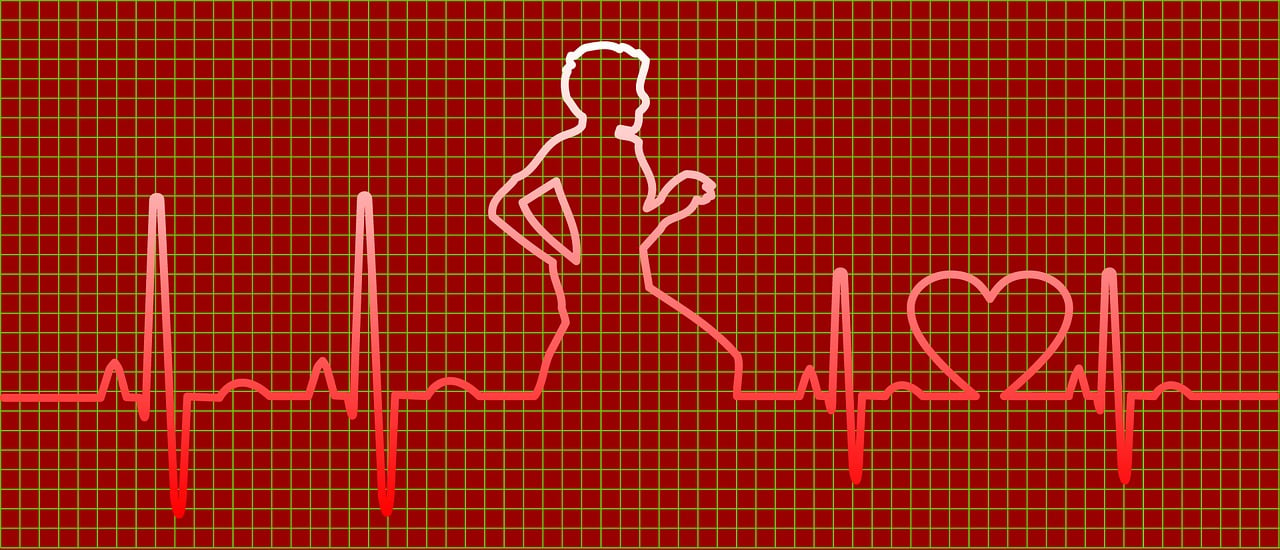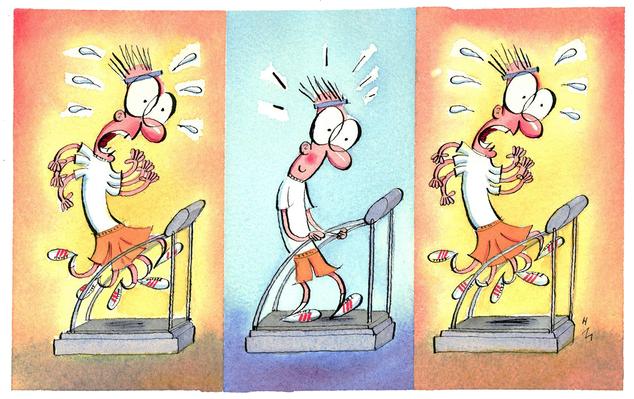Continuous and Interval Cardiovascular Exercise

An ancient knowledge, confirmed by science
The benefits of healthy lifestyle habits, including regular physical activity, have been known since Antiquity. Hippocrates, considered the “father of medicine,” already stated more than 400 years B.C. that movement was beneficial for health. Since then, science has only confirmed this intuition.
In the 1950s, an English researcher demonstrated that double-decker bus drivers, who sat all day, suffered more from cardiovascular disease than conductors who continuously climbed up and down the stairs. This was one of the first modern proofs that inactivity takes a heavy toll on the heart.
Living longer
Today, it is well established that gaining just one “MET” through exercise (a unit measuring the body’s ability to use oxygen) can reduce mortality risk by 10 to 25%. In other words, the fitter you are, the better your heart is protected.
For example, daily personal care activities require less than 5 METs, while a high-level tennis player can exceed 20 during a match.
During a stress test (treadmill examination), the healthcare professional measures not only the maximum heart rate achieved but also the number of METs performed. This number is a valuable indicator of both physical fitness level and cardiovascular prognosis.

A profitable investment
The benefits of exercise are particularly evident in sedentary people. Even small improvements in physical fitness bring significant gains in terms of health and longevity.

A large-scale impact
Physical activity acts on several fronts: it helps lower cholesterolCholesterol is essential for the proper functioning of the human body, but it can also have harmful effects if present in excess. >>, reduce bloodBlood is composed of red blood cells, white blood cells, platelets, and plasma. Red blood cells are responsible for transporting oxygen and carbon dioxide. White blood cells make up our immune defense system. Platelets contribute to blood pressure, stabilize bloodBlood is composed of red blood cells, white blood cells, platelets, and plasma. Red blood cells are responsible for transporting oxygen and carbon dioxide. White blood cells make up our immune defense system. Platelets contribute to blood sugar, and better control body weight. Together, these effects reduce the risk of developing diabetes with age and improve daily quality of life.
More broadly, regular exercise decreases premature mortality and reduces the risk not only of cardiovascular disease but also of certain cancers.
Slowing down aging
Regular movement does more than protect the heart: exercise also slows several effects of aging. Among others, it reduces the risk of falls and helps preserve cognitive functions.
Physical activity is also an ally for mental health, helping to reduce symptoms of depression and anxiety.
Even more important if your heart is sick
For people already living with heart disease, adapted exercise plays a vital role. After a heart attack, for example, regular physical activity can reduce the risk of recurrence by nearly 25% while also increasing life expectancy.
Of course, the program must be adjusted according to the heart condition and baseline fitness level. But one thing is certain: moving remains one of the best strategies to regain confidence and improve the future.

Aerobic Training Methods: Continuous or Interval?
International medical societies recommend engaging in at least 150 minutes of moderate to vigorous physical activity each week. This goal can be reached by accumulating several sessions of 10 minutes or more.
Don’t be discouraged: every bit of activity counts. As experts often say, “moving a little is always better than not moving at all.”
1 – Continuous Training
This method involves maintaining a constant intensity throughout the entire duration of exercise. It is the best-known and most widespread form of training.
The general recommendation is to exercise at an intensity between 60% and 80% of one’s maximum capacity.

– Calculating your maximum heart rate
To estimate this capacity, there is a simple formula: 220 minus your age = your maximum heart rate.
Example: for a 60-year-old person, the calculation is 220 – 60 = 160. Training at 60–80% corresponds to a heart rate between 95 and 130 beats per minute.
– How to know if the intensity is right?
In practice, it is an effort that makes you sweat and a little out of breath. However, you should still be able to talk while moving — this is known as the “talk test.”
– A matter of preference
Many activities allow continuous training: brisk walking, cycling, swimming, running… The choice mainly depends on individual taste and possibilities.
2 – Interval Training (HIIT)
Well known to athletes for a long time, high-intensity interval training — or HIIT — is now gaining popularity among the general public.

– The principle
It consists of alternating short periods of intense effort (beyond 85% of maximum capacity) with phases of active recovery or rest.
– The advantages
This method is particularly effective for:
- improving maximal performance (VO₂ max),
- promoting fat loss,
- achieving significant results in less time.
– Caution is needed
Interval training should be integrated gradually, especially for beginners or for people living with a medical condition. High intensity can increase the risk of muscle or joint injuries if not properly managed.
What about patients with heart disease?
If interval training (HIIT) has proven effective in healthy individuals, can it also benefit those with heart disease?
- VO₂ max and survival
Aerobic capacity, measured by VO₂ max, is closely linked to mortality risk in patients with coronary arteryThe two coronary arteries, the right and the left, form the blood network that supplies the heart with oxygen and nutrients. They are located directly on the surface of the heart and branch into smaller vessels that disease or heart failure. The higher the VO₂ max, the better the chances of survival.
- What is VO₂ max?
VO₂ max refers to the maximum amount of oxygen a person can use during intense exercise.
It can be compared to the “engine capacity” of a motor: the greater this capacity, the more oxygen the muscles receive, and the longer one can sustain effort without quickly becoming exhausted. This indicator is therefore considered a key measure of cardiovascular fitness.

The role of rehabilitation programs
Cardiac rehabilitation programs have long proven their effectiveness. Supervised by a specialized team, they help to:
- improve exercise tolerance,
- strengthen muscle mass and strength,
- and above all, increase quality of life.
The value of HIIT in rehabilitation
Cardiac rehabilitation programs, initially based on continuous training, have long demonstrated both their safety and effectiveness.
In recent years, particular interest has been given to integrating HIIT into cardiac rehabilitation. By alternating short periods of intense effort with phases of rest, even frail patients have been able to achieve significant improvements in exercise tolerance, sometimes greater than those observed with continuous training.
With proper supervision, everything is possible
However, this type of training should not be undertaken alone. It is essential to be supervised by a kinesiologist or a healthcare professional specialized in cardiac rehabilitation.
When properly guided, HIIT proves to be both safe and beneficial.

In summary
The benefits of physical activity are undeniable, both in healthy individuals and in those living with heart disease.
- True contraindications are rare, but caution remains important.
- Before beginning a program more demanding than simple walking, it is important to consult a physician.
- If necessary, the healthcare professional may refer the patient to an experienced kinesiologist.
Thus, adapted physical activity becomes a genuine treatment, just like medication or surgery, and contributes to prolonging and improving life.

A cornerstone for lifestyle change
Regular physical exercise, especially continuous aerobic training, is now recognized as a true cornerstone of non-pharmacological treatment in patients with heart disease.
When practiced consistently, it acts as a powerful lever that drives other beneficial changes: healthier eating, maintaining or regaining a healthy weight, reducing waist circumference, and sustainably quitting smoking when present. In other words, moving regularly encourages a global transformation of lifestyle.
Read more: Healthy lifestyle habits

Accessible programs
In almost every region of Canada, there are cardiac rehabilitation centers ready to support patients after a cardiac event. These programs are based on a multidisciplinary approach, where cardiologists, nutritionists, kinesiologists, and psychologists work together to support recovery and prevention.
These resources are invaluable: they provide tailored, safe, and motivating guidance to regain strength, rebuild confidence, and reduce the risk of recurrence.
The ball is in your court!
The evidence is clear and available to everyone: physical activity improves quality of life and extends longevity. Excuses fade in the face of a simple action: stand up, move, and keep going.
Every step counts. The most important thing is to start… and to continue.
























